How to make peas support?

Many owners of suburban and personal plots like to plant peas. This crop is undemanding to growing conditions, cold-hardy and yields a tasty harvest of sweet peas in early summer. But for the harvest to be really decent, the plants need support. Without it, you should not expect a good return from landing.
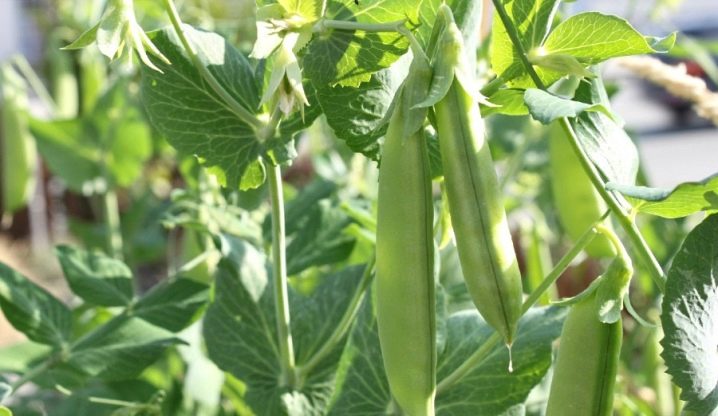
What is the support for?
Support for peas is needed already in the period when the height of its sprouts reaches 30 cm. An adult plant can rise up to two or more meters. Without support, it will not be able to stand upright due to the weakness of the stem. And therefore, already at a height of about 30 cm, peas are prone to lodging.
This should not be allowed for the following reasons:
- in a "creeping" position, individual plants are intertwined, which will complicate the subsequent collection of pods;
- stems, leaves and pods lying on the ground are prone to rot, shrinkage and other diseases;
- ripe pods can not always be found under the lying leaves and stems, they overripe, which gives the whole plant a "signal" about the end of the growing season; result - the plant begins to dry;
- yield and early ripening of planting are significantly affected: not all parts of the crop receive good lighting and are provided with fresh air.
If supported, the peas will stand upright, well lit and viewed from all sides. The pods will ripen evenly, and the peas will have normal juiciness and sugariness.
Cultivated planting of peas usually does not disturb dangerous diseases.
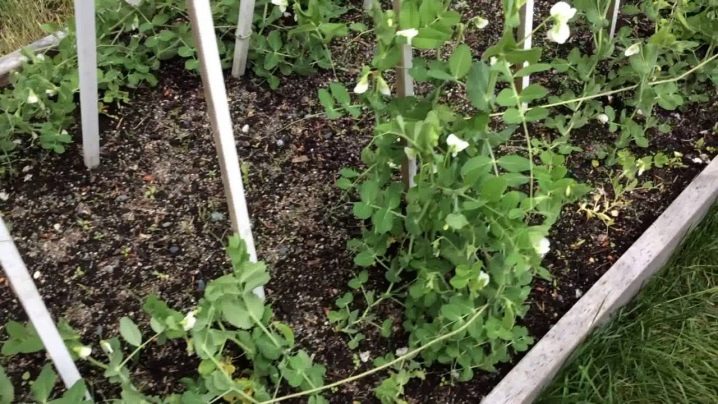
Timing of tying peas
When the first antennae begin to appear in the sprouts, the stems begin to be strengthened to the support by tying a twine or their antennae. Becheva is needed for the initial period of crop growth, especially in places where winds often blow. With gusts of wind, the still weak and few antennae may not hold onto the supporting structure, and the fragile stems that have been torn off may break. A little later, when the antennae reliably hold the plant, it is better to remove the string so that it does not cause damage to the stem. The first antennae grow back when the sprouts are about 20 cm high. As the peas grow, new antennae appear, which also hook onto the support.
In household plots and dachas, peas are often grown in the open field, leaving space in greenhouses for vegetables, which need to always be warm. And on the street there is a large selection of natural supports for it. For example, a fence made of a chain-link or palisade, planting a sunflower, a barn wall.
But if there is none of the above (or the peas are sown in the greenhouse), then it will not be difficult to build supports from the material at hand with your own hands.
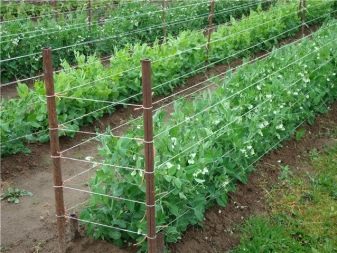
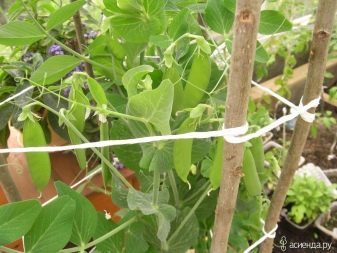
Types of devices
Supports for peas are recommended to be made even before sowing the seeds, so as not to disturb the seedlings and their roots later.
The following types of devices can be distinguished to support this climbing culture, which are most often found among gardeners:
- trellis supports;
- support stakes;
- constructions "hut" and "wigwam";
- rigid mesh.
Demand always determines supply. Of course, you can buy ready-made supports if you have free funds. For those who like to craft everything according to their desires and imaginations, there are the necessary materials on sale for the construction of a unique design for peas. And still others will collect support from what is in the farm and the neighboring forest, without spending a single ruble on it. But almost always every owner gets something similar to one of the devices mentioned above.This is due to the fact that the named structures are basic, invented a long time ago, and there are not so many other options yet.
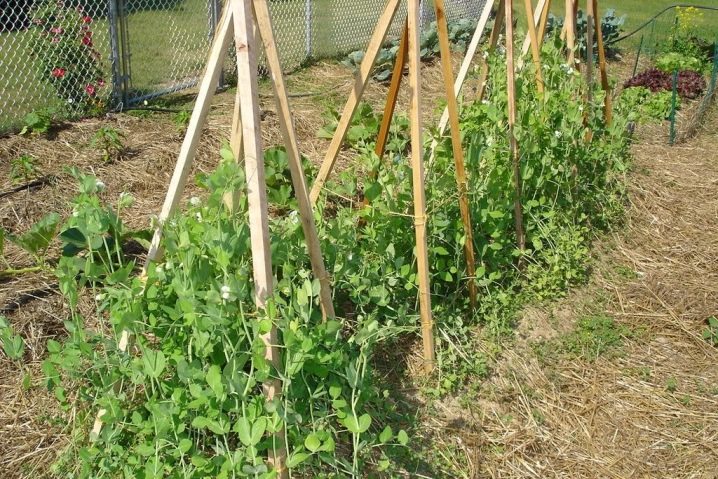
Ready
Among the ready-made supporting structures for peas, several of the most popular are worth highlighting.
- Support grid for peas U-45 made of non-decaying material 1x6 meters in size (brand "Protekt"). It is suitable for both short and tall varieties of plants grown in open and closed ground. The mesh size is 45 mm. For the winter, it must be removed, as it does not withstand low temperatures. For 6-meter beds with tall varieties of peas, you need to buy 2 such nets (the height of one is 1 m, and a support is needed at least two meters high).
- Tapestry mesh F-170 from a strong thread 1 mm thick and a cell of 150x170 mm. Roll size - 2x10 meters. Besides peas, it is used for cucumbers, beans, beans and ornamental plants. The mesh can withstand low temperatures. It is required to pick up the stakes-stands 2.5 meters long and drive them into the ground where the pea bed is planned. Manufacturer - NP "Protect".
- Trellis support mesh Rendell measuring 2x5 meters with a cell of 150 mm. It will be convenient when complete with a folding stand made of a wooden or welded frame (trellis portable support).
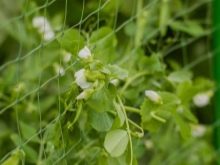


In addition to the trellis, on sale you can find a rigid mesh for supporting peas. It is unlikely that more of the listed devices can be found ready-made, but they are easy to make yourself.
Homemade
The presented devices are most often made by hand, so some of the novice gardeners may need a more detailed description of them.
- Trellis supports have different options, but the essence of all options is the same. At the ends of the pea beds, two metal or wooden posts are driven into the soil. The overhead height of the hammered pillars should be at least two meters for tall varieties of peas and 1.5 meters for low ones. Cords or trellis net are pulled between the posts. The next trellis is stretched at intervals of 15–20 cm in height. The mesh should be with cells no more than 10 cm.
- Stakes for support firmly driven into the bed at a distance of 40-50 cm from each other along its entire length. They will serve as a support for growing plants. For stakes, iron rods, branches of fruit trees and shrubs, tree stakes, thin pipes up to two meters long are used.


- Construction "hut" represents props made of long wooden poles, attached to each other in pairs in the form of a hut along the entire length of the bed. From above, the tops of all pairs are fastened together for strength with a "ridge". Several longitudinal poles on the inclined sides of the "hut" also serve to strengthen the structure. The peas are directed along the inclined poles to the ridge, clinging to the poles and to each other. The distance between the inclined pairs is about 1 meter, the length of the poles is 2 meters.
- Support, which is called "wigwam" has the shape of a pointed hut, similar to the dwellings of northern peoples and Indians. It is built from inclined poles, one end of which is stuck into the ground in a circle, and the other ends are tied together at the top of the resulting cone. A growing stalk of peas crawls along the outer sides of the structure, forming a pretty green slide. For such support, the sowing of seeds must be appropriate - around the base of the "wigwam".
- Rigid mesh support it is easy to install and therefore has a large number of different options: arches, vertical rows, vertical cylinders and inclined structures in the form of green arbors. For a rigid support, a galvanized mesh with a cell of 12.2 mm and greenhouse arcs are purchased. Plastic nets are also commercially available, but due to their short service life, they are not widely used among vegetable growers.
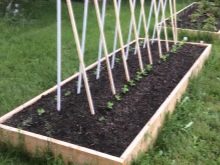

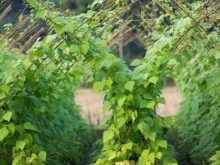
Advice
It is worth paying attention to a few tips from experienced gardeners when growing peas.
- Wooden fences can be used to support the peas. Their metal counterparts are not recommended to be used as a support for any climbing cultivated plants: heating in the sun, the metal can burn the stems of plants and lead to the death of plants.
- Low-growing peas should be sown two seeds per hole. Two stems will grow, which will support each other, so they will not need special supports.
- The ideal mesh size for trellis nets is less than 10 mm. But if there are no such ones on sale, you should not be upset - peas will also please on a support with a large mesh. You just need to look after the correct attachment of the pea antennae to the support.
For information on how to make a support for peas with your own hands, see the next video.



































































The comment was sent successfully.